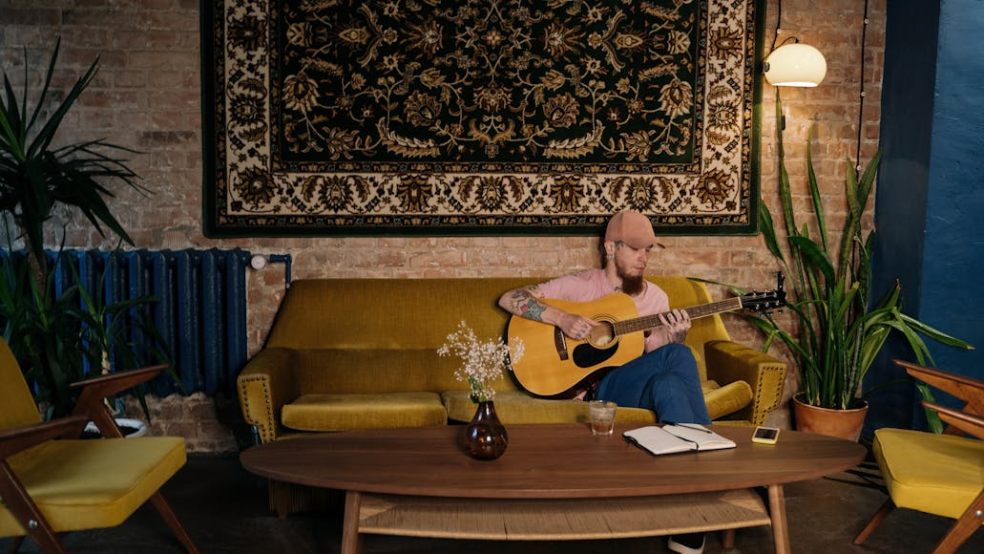
A Brief History of Tapestries and Murals
We often associate murals and tapestries as pieces of art and interior belonging to history, observing their captivating artistry predominantly in museums and galleries, forgetting that they were once an inseparable part of interior design as much as wall prints are today.
While both tapestries and murals are considered to be decorative art forms, they have had functional purposes throughout the centuries. And despite how much we associate them with history, designers do continue to turn to these two forms of art, for they haven’t ceased offering us something few other elements can — depth, character, and timeless storytelling.
While mass-produced decor takes over each corner of our homes, murals and tapestries invite our eyes to linger and our minds to wander. Why are they still holding such a powerful grip on our imagination? The answer is hidden in history.
The Difference Between Murals & Tapestries
Before we move through the centuries, it'll be good to take a moment to understand the differences between the two. ]
A mural is a piece of graphic work applied directly onto walls or ceilings, completely integrating itself into the architecture. Think The Sistine Chapel by Michelangelo and The Balloon Girl by Banksy.
A tapestry, on the other hand, is a woven textile created to be hung as a moveable piece of art. Some classic examples include the Bayeux Tapestry, which tells the story of William the Conqueror, and The Lady and The Unicorn tapestries, famous for their mysterious message.
Both, however, are panoramic, rich in detail, modes of storytelling and design. Due to their nature, murals depict scenes of grandeur, immersing you in grand storytelling that's often tied to the place they were painted. Tapestries, however, while still anchored in storytelling, were meant to be a moveable piece of decor, which absorbs sound and offers warmth in the otherwise stone-cold homes and castles of the past.
Ancient Origins
We may feel that both are ancient, but in fact, one is more so than the other. Murals date back tens of thousands of years, all the way to the prehistoric caves in France and Spain, where humans first felt the urge to record their lives through painted animals and symbols. For our prehistoric cousins, it was a way to communicate, connect and make sense of their environment. Later on, in ancient Egypt, murals adorned tombs, recalling the stories of those buried there and the people’s belief in the afterlife at the time.
In comparison, tapestries can be considered a modern invention. Well, almost. Their roots can be traced back to ancient Egypt and Peru, where they served decorative but also functional purposes, providing warmth and privacy and were often part of ceremonies.
Medieval & Renaissance: The Golden Age
Europe simply bloomed with tapestries at that time. Those vast stone castles with cold, echoing halls? They needed them to insulate the walls. But not only! Tapestries were a craft full of tradition that decorated interiors with scenes of mythology, battle, and noble lives. One of the most famous examples to this day is the Bayeux Tapestry, an astounding visual chronicle of the Norman conquest, stretching over 70 metres!
In parallel, murals flourished in sacred architecture. It was an age when only the clergy could understand the holy scripture, so churches relied on murals to create an immersive experience that helped the ordinary man visually understand the story of Christ through frescoes and mosaics. Therefore, murals were less of a decoration but rather a means of visual storytelling that educated people and helped them connect with the divine.
From Baroque to 19th Century: The Age of Opulence
The life of the nobility became more lavish during the Baroque and Rococo periods of art, and interior design only mirrored this trend. Royalty commissioned tapestries of the utmost craftsmanship from places like Aubusson and Gobelins in France to reflect their wealth, education, and cultural sophistication. No longer functional, tapestries had become a form of status.
It was also during the 19th century that William Morris resurrected the art of tapestry in Britain and turned the country into a haven for knotted carpets and textiles, often with styles still taking inspiration from the iconic medieval Gothic style.
Meanwhile, murals also shifted their purpose to become a statement in architectural design. Ceilings, domes, and stairwells were covered in highly-ornamented romantic imagery to fill the imagination wherever your eyes land. To this day, this maximalist aesthetic is one that many designers still reference in modern interiors.
20th Century and Contemporary Revival
The 20th century is known to have been one of many significant shifts, not only in history but also in the art that reflects it. At a time when modernists favoured clean lines and minimalism, ornate wall decor was forced to take a backseat. But not for long.
The Bauhaus movement, a champion of the unity of art and craft alongside functional design, elevated textiles to the status of fine art. Soon, tapestry emerged as another vibrant medium for abstraction and creative experimentation.
Murals were also not yet forgotten. From grand architecture, they moved into public spaces and shifted their purpose from religious storytelling to artistic activism and social commentary. This was thanks to artists like Diego Rivera, who used walls to deliver political and cultural narratives.
In the context of interior design, however, murals have evolved into custom interiors, no longer the epitome of grandeur but edginess and accessibility. No longer reserved for spiritual or mythological storytelling, they now reflect deeply personal narratives.
The Designer’s Perspective Today
According to some artists and designers, tapestries and murals are currently experiencing a second renaissance. Why? Because of their most specific characteristic: adding soul to a space. Today, tapestries evoke a sense of handcrafted luxury inspired by history, while murals can turn a wall into an immersive dreamscape.
Designers love them for their tactile richness, customisation, narrative power, and, beyond all that, their practical function. You’ve probably seen their contemporary applications already in muralled powder rooms, dramatic dining room ceilings, and textile wall art panels in modern homes.
So, if you thought tapestries and murals were relics, you couldn’t be more wrong. They have sprung up from the far corners of history and followed humankind through the centuries because they offer more than beauty. To this day, they bring depth and are a constant reminder of the power of human artistry.













